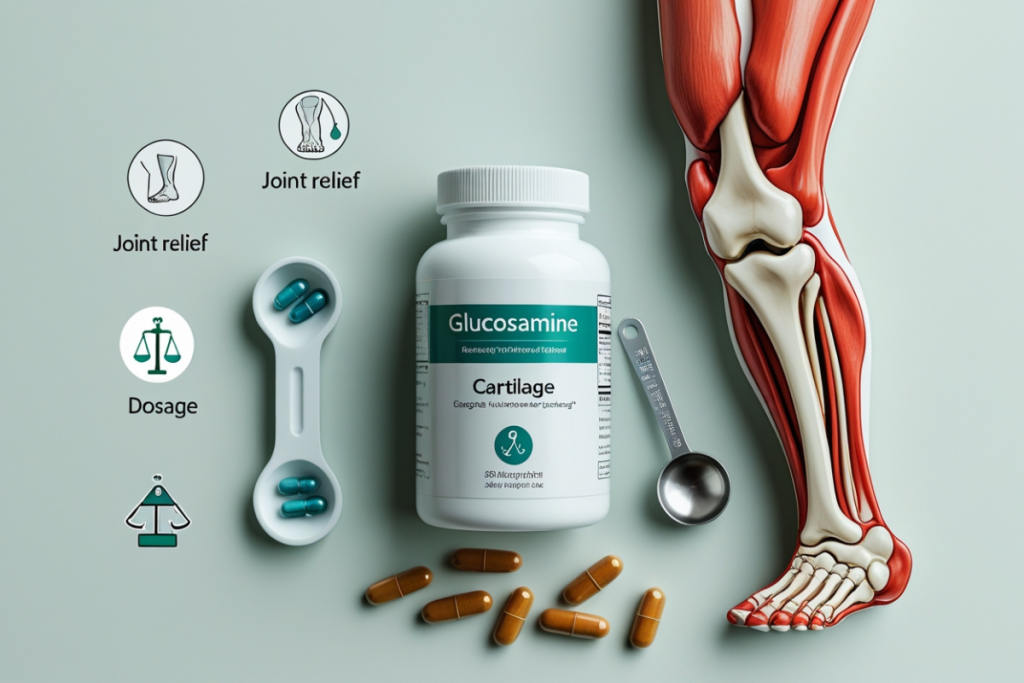Glucosamax is a popular joint supplement containing glucosamine, often paired with other ingredients like chondroitin or MSM. It’s marketed to relieve arthritis pain and improve joint mobility. In this article, we’ll explore what glucosamine is (and why a supplement called Glucosamax might help), review the latest research on its benefits and efficacy, explain the recommended dosage, and outline possible side effects and precautions. By examining scientific studies and expert guidelines, we’ll answer the key question: does glucosamine really work? We’ll also mention related products like Joint Flex Glucosamax and Joint Flex Glucosamax Plus, which blend glucosamine sulfate (1500 mg) with other joint-support nutrients.

What Is Glucosamine (and Glucosamax)?
- Natural Compound in Joints: Glucosamine is a natural amino sugar found in healthy cartilage (the cushioning tissue in joints). The body uses glucosamine to build glycosaminoglycans, which are part of cartilage structure. In osteoarthritis (OA), cartilage breaks down, and glucosamine supplements are theorized to help rebuild cartilage or slow deterioration.
- Supplement Forms: In supplements, glucosamine comes mainly as glucosamine sulfate or glucosamine hydrochloride. These are not interchangeable – most evidence focuses on the sulfate form. Typical glucosamine dosage in studies is 1,500 mg per day of glucosamine sulfate, often taken once daily.
- What is Glucosamax? Glucosamax is a brand name for a joint-support supplement that usually contains glucosamine (often 1000–1500 mg of glucosamine sulfate per serving) along with other nutrients like chondroitin and methylsulfonylmethane (MSM). Similarly, products named “Joint Flex Glucosamax” or “Joint Flex Glucosamax Plus” typically blend glucosamine sulfate (1500 mg) with additional ingredients (e.g. boswellia, turmeric, collagen) to enhance joint support. These combination formulas aim to reduce inflammation and improve joint comfort through multiple pathways.
- Mechanism of Action: Glucosamine supplements are thought to help joints in two ways:
- Cartilage support: They supply raw material (sulfur and building blocks) for cartilage repair, potentially stimulating chondrocytes (cartilage cells) to maintain cartilage. This may slow cartilage breakdown.
- Anti-inflammatory effects: Glucosamine and chondroitin have mild anti-inflammatory properties, which could reduce joint swelling and pain. In theory, by protecting cartilage and reducing inflammation, these supplements can improve joint mobility.
Benefits of Glucosamine (Glucosamax) and Joint Support
Many people take glucosamine (including Glucosamax) for osteoarthritis pain relief and joint health. Let’s review reported benefits and clinical findings:
- Pain and Stiffness Relief: Some studies show that glucosamine sulfate can reduce joint pain and stiffness in osteoarthritis of the knee. For example, Mayo Clinic notes that “oral use of glucosamine sulfate might provide some pain relief for people with osteoarthritis of the knee”. A 2022 Harvard review found that treating knee or hip OA with glucosamine (often combined with chondroitin) led to small improvements on pain scales, though the clinical significance was unclear.
- Reduced NSAID Use: By lessening pain, glucosamine may let some patients cut back on anti-inflammatory painkillers. One 2-year cohort study cited by Healthline found that taking 1500 mg of crystalline glucosamine daily led to a 36% reduction in NSAID use among participants. This suggests glucosamine could be a helpful option for people who want to avoid long-term NSAID side effects.
- Slowing Cartilage Loss: Some long-term trials indicate glucosamine sulfate might slow cartilage loss. Two notable European trials (using 1500 mg/day of a prescription-grade glucosamine sulfate called Dona) showed modest slowing of joint-space narrowing on X-rays. In these studies, patients on glucosamine had slightly less cartilage loss than those on placebo over 3 years. However, symptom improvement didn’t always match these structural changes.
- Improved Function: A large UK trial (GAIT) and others show mixed results, but some subgroups (e.g. people with moderate-to-severe pain) did feel more relief on glucosamine. Another study (MOVES trial) reported that combined glucosamine+chondroitin was as effective as celecoxib (an NSAID) in reducing knee OA pain and swelling, suggesting these supplements could be alternatives for people who cannot tolerate NSAIDs.
- Synergy with Other Ingredients: Supplements like Glucosamax or Joint Flex often include chondroitin, MSM, boswellia, or turmeric. These ingredients themselves have anti-inflammatory properties. The combined effect may provide more relief than glucosamine alone, although research on these combinations is limited. Manufacturers claim added benefits, but high-quality studies isolating each component are few.
- Overall Summary of Benefits: In practice, some people report meaningful pain relief and improved mobility from glucosamine (with or without chondroitin). It’s generally safe and may be worth a trial for those with OA or chronic joint pain, especially if conventional medications aren’t suitable. As Harvard’s review notes, if patients feel relief, “they may not care so much about individual studies”.
Scientific Evidence: Does Glucosamine Really Work?
Despite its popularity, scientific studies on glucosamine (and products like Glucosamax) have yielded mixed results. Here’s what experts say:
- Mixed Research Results: Large analyses show conflicting outcomes. A 2022 analysis of nearly 4,000 OA patients found “no convincing evidence that glucosamine and chondroitin provided major benefit”. Similarly, the U.S. NIH-funded GAIT trial reported no significant relief from glucosamine+chondroitin combined, except a small effect in a subgroup with severe pain. Reviews have noted that some studies (especially older or manufacturer-funded) reported benefits, while many rigorous trials found no advantage over placebo.
- Clinical Guidelines Disagree: Medical guidelines vary globally:
- The American College of Rheumatology (ACR) and Arthritis Foundation (2019) strongly discourage using glucosamine for knee OA, concluding the “best data do not show any important benefits”.
- The Osteoarthritis Research Society International (OARSI) guideline (2019) also advises against it due to low-quality evidence.
- In contrast, the American Academy of Orthopaedic Surgeons (AAOS) guideline (2021) lists glucosamine as a supplement that may be helpful for mild-to-moderate knee OA, albeit with inconsistent evidence.
- European experts (ESCEO) strongly recommend prescription-grade crystalline glucosamine sulfate for knee OA, but caution against other over-the-counter forms.
- Quality and Formulation Matters: Evidence suggests that brand and formulation influence results. Prescription or pharmaceutical-grade glucosamine sulfate (used in some European trials) tended to show better outcomes than random over-the-counter supplements. In fact, one meta-analysis found “risk of bias and brand explain the observed inconsistency” in glucosamine trials. High-quality studies funded by manufacturers (often in Europe) showed benefits, while many independent trials did not. This may mean some OTC glucosamine products (like random glucosamine supplements) have variable quality.
- Controversy and Ongoing Debate: Authorities like Harvard and Mayo emphasize that glucosamine is “controversial” due to conflicting studies. Some experts keep an open mind: the AAFP (American Family Physician) states “there is no clear evidence to recommend against its use,” and suggests a personal trial is reasonable. On the other hand, many doctors point out that if someone tries glucosamine (or Glucosamax) without benefit after a few months, it’s best to stop.
- Bottom Line on Efficacy: No miracle cure, but possible modest benefit. The consensus is that glucosamine is safe and may help some people, but it isn’t a proven major treatment. Harvard Health notes “Even if a treatment is not effective on average, there may be folks who… get real relief from it”. In other words, while many studies show no significant effect, some individuals do feel better taking glucosamine. It’s often described as a “worth-a-try” supplement for joint pain, with the caveat that evidence is weak.
Glucosamine (Glucosamax) Dosage and How to Take It
- Typical Dosage: The standard daily dose in studies is 1,500 mg of glucosamine sulfate (often taken all at once or split into 3 doses of 500 mg). If you’re using a glucosamine HCl product, the equivalent is slightly different (typically 2,000–2,400 mg of HCl for a similar effect). Most labels on products like Glucosamax will specify 1500 mg of glucosamine sulfate per serving or 1000 mg twice daily, etc. Always follow the label instructions or your doctor’s advice.
- Form (Sulfate vs HCl): As noted, glucosamine sulfate is the form with the most supportive data. Some products use glucosamine hydrochloride (HCl), which may be less studied. Check labels carefully. Glucosamax and similar brands usually specify glucosamine sulfate 1500 mg because that’s the common effective form.
- With or Without Food: Glucosamine can be taken with food to avoid stomach upset. It’s a long-term supplement, so consistency matters more than exact timing.
- Duration of Trial: Experts suggest trying glucosamine for at least 6–12 weeks before judging its effectiveness. The AAFP advises a 60-day trial (about 2 months). If you don’t notice meaningful improvement after a few months, it’s reasonable to discontinue.
- Combining with Other Supplements: Sometimes glucosamine is paired with chondroitin, MSM, boswellia, or hyaluronic acid in formulas. Products labeled “Glucosamax” or “Joint Flex Glucosamax Plus” typically already include these. If taking separate supplements, be aware not to exceed the recommended glucosamine dose, and consider potential interactions.
- Joint Flex Glucosamine vs Glucosamax: Though not standard medical terms, products named Joint Flex Glucosamine or Joint Flex Glucosamax Plus are essentially enhanced formulas of glucosamine with extra joint-supporting ingredients (e.g. 1500 mg glucosamine sulfate + chondroitin, MSM, vitamin C, boswellia, etc.). They generally follow the same dosing of 1500 mg glucosamine per day. The key is that these combos may target multiple aspects of joint health (inflammation, cartilage matrix, etc.), but clinical data for the specific branded combinations is sparse.
- Children and Pregnancy: Glucosamine supplements are generally studied in adults. Little is known about safety in children, pregnant or nursing women. If you fall into these categories, consult a doctor before use.
Side Effects and Precautions
Glucosamine (and products like Glucosamax) is generally well-tolerated, but side effects and precautions are important:
- Common Side Effects: Most people have no issues, but possible gastrointestinal symptoms include:
- Nausea or stomach upset
- Heartburn or indigestion
- Diarrhea or constipation
- Headache or drowsiness
- Skin reactions (rare)
- These side effects are usually mild. Harvard reports some people experience heartburn, abdominal pain, diarrhea, drowsiness, or headaches.
- Allergic Reactions: Because glucosamine is often derived from shellfish shells, there’s a risk of allergy. People with severe shellfish allergies should use caution. However, it’s the shell of the crustacean that provides glucosamine, not the flesh – many studies have found that glucosamine supplements are safe even for many with shellfish allergies. Still, if in doubt, choose a shellfish-free or lab-made glucosamine, and watch for allergy symptoms (rash, itching, swelling).
- Blood Sugar: Some older reports suggested glucosamine might raise blood sugar, but most studies show it doesn’t significantly affect glucose in diabetics. NCCIH notes “glucosamine may cause increases in blood glucose in some people,” though evidence is mixed. If you have diabetes, monitor blood sugar and consult your doctor.
- Bleeding Risk (Warfarin): Glucosamine (especially with chondroitin) can increase the effects of the blood thinner warfarin (Coumadin), raising bleeding risk. If you take anticoagulants, talk to your healthcare provider before starting glucosamine.
- Asthma: Some reports suggest glucosamine could worsen asthma symptoms in sensitive individuals. If you have asthma, monitor lung function and consult your doctor when starting any new supplement.
- Pregnancy/Breastfeeding: There’s insufficient research on glucosamine in pregnant or nursing women, so medical advice is recommended before use.
- Quality and Contaminants: Supplements aren’t FDA-regulated as strictly as drugs. Harvard notes that glucosamine products might not always contain the labeled amount and could have contaminants. To minimize risk:
- Choose reputable brands that do third-party testing.
- Look for products certified by groups like USP, NSF, or ConsumerLab.
- Check if the label clearly states “glucosamine sulfate” (not just “glucosamine 1500 mg” which might be HCl).
- Other Drug Interactions: Besides warfarin, glucosamine appears safe with most medications. Mayo Clinic does note a possible interaction with acetaminophen (Tylenol) where glucosamine might reduce each other’s effectiveness. Sticking to recommended doses minimizes concerns. Always discuss new supplements with your doctor if you take other medications.
How to Choose a Glucosamine (Glucosamax) Supplement
If you decide to try glucosamine, here are tips for selecting a good product:
- Form and Dosage: Look for glucosamine sulfate (not HCl) at a dose of 1500 mg per day. Some labels may say 1500 mg of “glucosamine sulfate (equivalent to 1171 mg glucosamine)”. That’s fine. Avoid products with much lower doses (like 250 mg only).
- Additional Ingredients: Many supplements add chondroitin (usually 800–1200 mg), MSM (100–500 mg), or anti-inflammatories (boswellia, turmeric, collagen). These can complement glucosamine but make the label more complex. If you get a product like Joint Flex Glucosamax Plus, it probably has these. Read labels to know what you’re getting. (For example, Glucosamax might include 1000 mg glucosamine + 500 mg chondroitin + 300 mg MSM per serving.)
- Brand Reputation: Choose established brands or pharmacies. For instance, products named Glucosamax or Joint Flex may come from specific supplement companies. Check for customer reviews, certifications, and return policies.
- Form: Glucosamine comes as capsules, tablets, powders, or liquids. Capsules/tablets are most common. Powder can be mixed with liquids. Liquid drops exist but are less studied.
- Storage: Keep the bottle in a cool, dry place. Check expiration dates. AAFPs recommend stopping if the supplement doesn’t help after a few months.
FAQs About Glucosamine and Glucosamax
Q: Can Glucosamax or other glucosamine supplements cure arthritis?
A: No supplement cures arthritis. Glucosamine (like in Glucosamax) may help relieve symptoms of osteoarthritis (pain, stiffness) in some people, but it does not reverse arthritis. Studies show at best modest benefits for pain relief. Think of it as a potentially helpful add-on rather than a standalone cure.
Q: How long until I see results from glucosamine?
A: Unlike a pain pill that works immediately, glucosamine is often given 2–3 months to see effects. Experts suggest a 60–90 day trial. Some people notice gradual improvement in joint comfort over a month or two; others may not notice any change. If after ~3 months there’s no benefit, it’s reasonable to stop.
Q: Is 1500 mg of glucosamine safe?
A: Yes, 1500 mg per day (usually as one dose) is the standard safe dose used in studies. Higher doses (like 2000–2400 mg) are sometimes used if using glucosamine HCl form. Always follow the label or your doctor’s advice. Staying at or below 1500–2000 mg daily minimizes side effect risk.
Q: Can I take glucosamine with my other meds?
A: In most cases, glucosamine is safe with common medications. However, warfarin (a blood thinner) is a known interaction: glucosamine (especially with chondroitin) can increase bleeding risk. If you take warfarin or similar, talk to your doctor. Also mention any allergy to shellfish or issues like diabetes or asthma before starting.
Q: Does glucosamine work better with chondroitin?
A: Glucosamine and chondroitin are often paired. Some studies tried them together versus separately. Results are mixed. A large study (GAIT) showed no added benefit of the combination over placebo overall, though other research suggests certain people might benefit more from the combo. Some guidelines advise taking them together, but the evidence isn’t conclusive. If your supplement (like Glucosamax) includes chondroitin, you’re already combining them.
Q: Are there non-drug ways to improve joint pain?
A: Yes, besides supplements, strategies include weight loss (if needed), exercise (like strengthening and low-impact cardio), physical therapy, and topical pain relievers. These lifestyle approaches have strong support and can be used alongside supplements. Think of glucosamine as one part of a joint-health regimen, not the only one.
Conclusion
Glucosamine (the key ingredient in Glucosamax and similar joint formulas) remains a popular supplement for osteoarthritis and joint health. Current research shows mixed evidence: some people report meaningful relief, but many clinical trials see little to no difference from placebo. The supplement is generally safe and may be worth trying (especially if you cannot take NSAIDs), but set realistic expectations. If you notice clear improvement in a few months, you might continue; if not, it’s reasonable to stop.
Key Takeaways: Glucosamax (and similar glucosamine sulfate supplements) might modestly ease joint pain and stiffness for some patients. The usual dose is 1500 mg daily. Side effects are usually mild (e.g. stomach upset, headache), but be cautious if you have shellfish allergies, are on warfarin, or have asthma.
Engagement: Have you tried Glucosamax or another glucosamine supplement? What was your experience? Share your thoughts below! If you found this guide helpful, please share it with friends dealing with joint pain.





